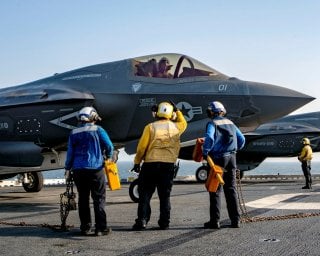Here's an Idea: Merge U.S. Marine Stealth F-35s and Lasers
The U.S. Navy is developing a laser-application for its Marine Corps F-35B intended to effectively maintain the stealth fighter for future decades of war.
The U.S. Navy is developing a laser-application for its Marine Corps F-35B intended to effectively maintain the stealth fighter for future decades of war.
After all, the aircraft is, one might say, in its operational infancy and expected to fight until at least 2070 since the F-35B variant was the first to enter service. Therefore, many of the existing F-35Bs have certainly been flying long enough to benefit from sustainment efforts. The Corps vertical takeoff and landing F-35B variant is now operating on several Navy amphibious assault ships, including the new America-class.
The laser application, called “laser shock peening,” strengthens and preserves the aircraft’ s smooth stealthy exterior and composite metal materials.
A Navy report describes laser shock peening as a unique process producing a uniform result across the surface treated. According to a news report published on Navy.mil:
“In laser shock peening, the surface of the media is first coated with an ablative layer and covered with a water tamping layer. A high-energy laser beam is fired at the metal, which creates an area of plasma on the metal’s surface. The impact creates a shock wave, which travels through the metal, and compressive residual stresses remain. This compression helps improve the metal’s damage tolerance, fatigue life and strength.”
With technology verification and industry preparations already underway, laser shock peening will formally begin next year at a new F-35 depot facility now being finalized. The 16,000-square-foot facility comprises two bays, where the actual laser shock peening process will take place, and a connected area that will house the laser generator, according to the Navy report.
It is important to get the process right and to incorporate technology advancements. Laser peening will replace the legacy approach, called “shot peening.” That old method meant spraying solid material such as glass beads or metals in kind of a sandblast fashion. “You just randomly throw it at the surface, and it creates all these surface dimples. What you get is a very inconsistent surface profile, because it’s not controlled,” Matthew Crisp, the F-35 Joint Program Office site lead at Fleet Readiness Center East explained in the report.
The new laser process, by contrast, will strengthen the design without adding metal or weight. This is of great significance, because among other things, the F-35 is built with a special blend of composite materials to minimize weight and drag while ensuring the curved, radar-absorbent stealth exterior is maintained. Such a process is naturally of greatest importance when it comes to flying with weapons lodged in an internal weapons bay so as not to expose contours and shapes potentially vulnerable to enemy radar detection. The process, Crisp said, has been used on the F-22 Raptor and various aircraft components.
Preserving a smooth exterior, without any kind of indentation is of critical importance to the F-35s stealth properties. Not only is the coating itself engineered to absorb enemy radar signals, but its smoothness is also critical. Should there be shapes or indents, even very small ones, they could compromise the fighter’s smooth exterior and increase the radar signature of the aircraft. Electromagnetic pings are able to send a clearer return signal when they can bounce off edges, shapes or other configurations able to render an image of an object. The F-35 is, according to Lockheed Martin engineers, built with specific bolts, seams, curved edges and smooth, curved protruding structures by design from its inception. Continued functionality, it goes without saying, relies upon the sustainment of the effects of these engineering techniques.
Kris Osborn is the defense editor for the National Interest. Osborn previously served at the Pentagon as a Highly Qualified Expert with the Office of the Assistant Secretary of the Army—Acquisition, Logistics & Technology. Osborn has also worked as an anchor and on-air military specialist at national TV networks. He has appeared as a guest military expert on Fox News, MSNBC, The Military Channel, and The History Channel. He also has a Masters Degree in Comparative Literature from Columbia University.
Image: Reuters

